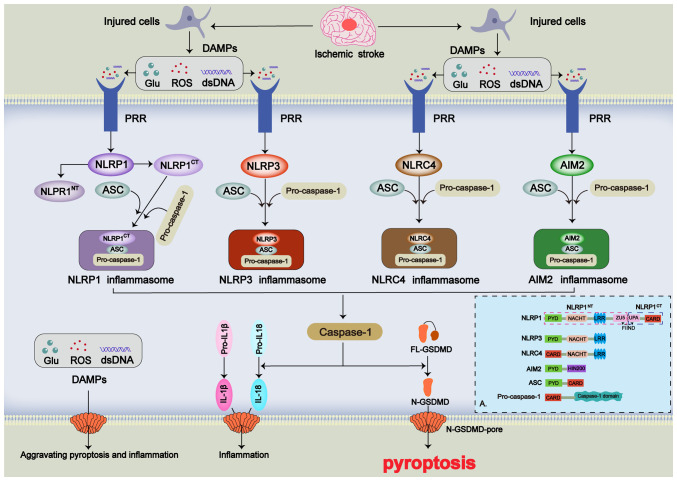Figure 4.
Potential mechanisms of IS-induced pyroptosis. During IS pathology, DAMPs released from injured cells can bind to PRRs on the cell membrane and activate downstream inflammasomes. PRRs include NLRs and Toll-like receptors, and inflammasomes include NLRP1 inflammasomes, NLRP3 inflammasomes, NLRC4 inflammasomes and AIM2 inflammasomes. Activation of inflammasomes promotes the formation of N-GSDMD and causes pyroptosis. After pyroptosis occurs, intracellular DAMPs are released and further aggravate pyroptosis and the inflammatory response. (A) Schematic diagram of protein structural domains. AIM2, absent in melanoma 2; ASC, apoptosis-associated speck-like protein containing a CARD; CARD, caspase recruitment domain; CT, C-terminal; DAMPs, damage associated molecular patterns; dsDNA, double-stranded DNA; FIIND, function to find; FL-GSDMD, full-length gasdermin D; Glu, glutamate; HIN200, hematopoietic interferon-inducible nuclear protein with a 200-amino acid repeat; IS, ischemic stroke; LRR, leucine-rich repeat; N-GSDMD, N-terminal gasdermin D; NLR, NOD-like receptor; NLRC4, NLR family CARD domain containing 4; NLRP, NLR family pyrin domain containing; NT, N-terminal; PRR, pattern recognition receptor; PYD, pyrin domain; ROS, reactive oxygen species; UPA, ubiquitin protease associated domain; ZU5, ZO-1 and Unc5-like domain 5.

